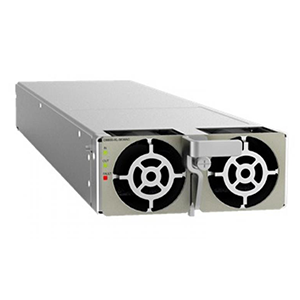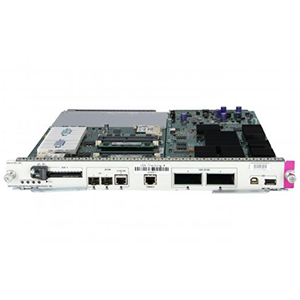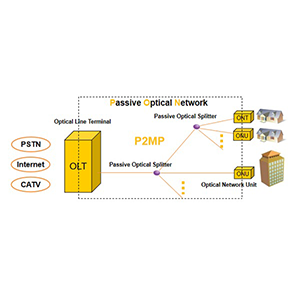As a communication network based on optical fiber transmission technology, Passive Optical Network (PON) realizes signal transmission and distribution through passive optical splitters without the need for active photoelectric conversion equipment. In the context of today’s information age, PON, as a high-speed, high-bandwidth solution, is gradually becoming the mainstream technology in the field of broadband access. This article will introduce the definition, principle, composition and architecture of passive optical networks, discuss its application in broadband access, as well as future development trends and prospects.
What is a passive optical network
Passive Optical Network, (PON for short) is an optical fiber communication technology used to transmit data and provide broadband access services in optical fiber networks. Compared with traditional active optical networks, passive optical networks do not require the use of active photoelectric conversion equipment (such as optical transmitters and optical receivers), but achieve signal transmission and distribution through optical splitters and optical fiber transmission media.
In passive optical networks, optical signals are transmitted from optical line terminals (OLT, Optical Line Terminal) to user-side optical network terminals (ONT, Optical Network Terminal) through optical fibers. Optical splitters are used to distribute optical signals to multiple users, and each user is connected to an ONT. ONT converts optical signals into electrical signals for use by user equipment (such as computers, phones, televisions, etc.).
The composition of passive optical networks
-
Optical Line Terminal (OLT, Optical Line Terminal): OLT is the core equipment of the passive optical network, usually located in the central office or data center of the service provider. It is responsible for managing and controlling the entire optical network, connecting with upper-layer networks (such as the Internet), and providing data and services to the user side.
-
Optical splitter (Splitter): Optical splitter is an important component in passive optical networks, used to distribute optical signals from OLT to multiple users. Optical splitters have one input port and multiple output ports, usually in the form of fiber optic couplers or arrayed waveguide couplers. Through optical splitters, optical signals can be distributed to different user terminals (ONTs).
-
Optical fiber transmission medium: Passive optical networks use optical fiber as the transmission medium to transmit optical signals from the OLT to the user side. Optical fiber has the characteristics of low loss and high bandwidth, and can support long-distance signal transmission.
-
Optical Network Terminal (ONT, Optical Network Terminal): ONT is located on the user side and is usually installed in the user’s home, office or other location. Each user connects to one ONT. The ONT is responsible for receiving optical signals from optical fibers and converting them into electrical signals for use by user equipment. The ONT is also responsible for converting the electrical signals generated by the user equipment into optical signals and sending them back to the OLT.
-
Optical module (Transceiver Module): The optical module is a key component in ONTs and OLTs and is used to convert photoelectric signals. It is capable of converting optical signals into electrical signals and electrical signals into optical signals. Optical modules usually include optical transmitters and optical receivers for sending and receiving optical signals.
-
Fiber optic connectors: Fiber optic connectors are used to connect optical fibers and various components, including OLT, optical splitter, ONT and optical modules. They ensure correct alignment between fiber cores and low-loss signal transmission.
In addition to the above main components, passive optical networks may also include other auxiliary equipment such as optical attenuators, fiber optic cross-connect equipment, fiber optic patch panels, etc. to meet specific network needs and layout requirements.
Working principle of passive optical network
-
Optical Line Terminal (OLT): OLT is the core equipment of a passive optical network and is usually located in a service provider’s central office or data center. The OLT is responsible for managing and controlling the entire optical network, as well as the connection to the upper layer network (such as the Internet). It sends optical signals to the user side and receives optical signals from the user side.
-
Optical splitter: Optical splitter is a key component in passive optical networks. It is used to distribute optical signals from OLT to multiple users. An optical splitter has multiple ports, each port corresponding to a user.
-
Optical fiber transmission: Optical signals are transmitted from the OLT to the user side through the optical fiber transmission medium. Optical fiber has the characteristics of low loss and high bandwidth, and can support long-distance transmission.
-
Optical Network Terminal (ONT): ONT is located on the user side and installed in the user’s home, office or other location. Each user connects to one ONT. The ONT is responsible for receiving optical signals from optical fibers and converting them into electrical signals for use by user equipment.
-
Optical signal conversion: After ONT converts optical signals into electrical signals, user equipment (such as computers, phones, TVs, etc.) can use these electrical signals for data transmission and communication.
-
Uplink and downlink transmission: Passive optical networks support uplink and downlink transmission. In downlink transmission, the OLT sends data and services to the user side, and each user’s ONT receives the corresponding data. In uplink transmission, the user equipment sends data to the OLT through the ONT.
-
Time division multiplexing (TDM): Passive optical networks usually use time division multiplexing technology, such as G-PON (Gigabit Passive Optical Network) or EPON (Ethernet Passive Optical Network). These technologies use time slots to allocate bandwidth among different users to achieve shared bandwidth among multiple users.
Passive optical network standards and technologies
-
G-PON (Gigabit Passive Optical Network): G-PON is one of the most widely used passive optical network technologies. It is based on the G.984 series of recommendations of ITU-T (International Telecommunications Union Telecommunication Standardization Sector) and supports symmetrical uplink and downlink rates, usually 1.25 Gbps. G-PON uses time division multiplexing (TDM) technology to allocate bandwidth to different users.
-
EPON (Ethernet Passive Optical Network): EPON is a passive optical network standard based on Ethernet technology. It is based on the IEEE 802.3ah standard and supports Ethernet protocol and frame structure. EPON usually has symmetrical uplink and downlink rates, which can reach 1 Gbps. EPON uses time division multiplexing (TDM) technology at the transport layer.
-
XG-PON (10G Passive Optical Network): XG-PON is a high-speed passive optical network technology that supports higher transmission rates. It is based on ITU-T’s G.987 series of recommendations and provides symmetrical uplink and downlink rates, which can reach 10 Gbps. XG-PON uses wavelength division multiplexing (WDM) technology to allow multiple wavelengths of optical signals to be transmitted simultaneously on the same optical fiber.
-
NG-PON2 (Next-Generation Passive Optical Network 2): NG-PON2 is the next generation passive optical network technology used to provide higher transmission rates and more services. NG-PON2 is based on ITU-T’s G.989 series of recommendations and supports symmetric and asymmetric uplink and downlink rates, which can reach 40 Gbps or above. NG-PON2 uses wavelength division multiplexing (WDM) technology to support optical signal transmission of multiple wavelengths.
Application fields of passive optical networks
-
Broadband access: Passive optical networks are one of the main technologies for providing broadband access. It can provide high-speed and stable Internet access services through optical fiber transmission to meet the large bandwidth needs of users such as homes, offices, and enterprises.
-
Telecom operator networks: Passive optical networks are widely used in telecom operators’ networks to provide a variety of services such as voice, data and video. It enables efficient bandwidth sharing and resource utilization, reduces network costs, and provides reliable connectivity and service quality.
-
Campus network: Passive optical networks also have important applications in campus networks. It can provide high-speed broadband access to schools, universities and research institutions, supporting online education, distance learning and research activities. The high bandwidth and reliability of passive optical networks can meet the simultaneous access needs of large-scale users.
-
Metropolitan Area Network (MAN): Passive optical networks can be used to build metropolitan area networks to connect office buildings, enterprises and institutions in different areas. It provides high-speed, secure data transmission and supports various applications such as remote office, cloud services and data center connectivity.
-
Video surveillance and security systems: Passive optical networks are widely used in the fields of video surveillance and security. It can transmit large amounts of high-definition video data through optical fiber, enabling long-distance transmission and multi-point layout. The high bandwidth and low latency of passive optical networks help provide high-quality, real-time video surveillance services.
-
Rural and remote area networks: Passive optical networks can also be extended to rural and remote areas to provide broadband access and Internet services to these areas. The advantages of fiber optic transmission allow data to be transmitted over long distances and are less susceptible to interference, thus improving network connectivity in these areas.
Future development trends of passive optical networks
-
High-speed transmission: As data demand continues to grow, passive optical networks will develop towards higher transmission rates. Current standards such as XG-PON and NG-PON2 already provide transmission rates of 10 Gbps and above, and higher-speed standards and technologies may appear in the future to meet the growing bandwidth needs.
-
Multi-service support: Future passive optical networks will support more types of businesses and services. In addition to traditional broadband access, more and more applications, such as 5G mobile communications, Internet of Things (IoT), cloud computing, etc., will require passive optical networks to provide more bandwidth and low-latency transmission to support a variety of business needs.
-
Network intelligence: Passive optical networks will develop in a more intelligent direction. By introducing intelligent algorithms and machine learning technology, passive optical networks can achieve more efficient resource management, fault detection and optimization. Intelligent network management and operation and maintenance will improve network reliability, scalability and service quality.
-
Integration of optical fiber and wireless: The integration of optical fiber and wireless communication technology is an important trend in future passive optical networks. By combining wireless access technologies (such as wireless LAN, 5G) with passive optical networks, more flexible and high-capacity wireless access solutions can be provided. This convergence will bring new opportunities and challenges to mobile communications, broadband access and wireless network expansion.
-
Cybersecurity and privacy protection: As digitalization increases, cybersecurity and privacy protection become increasingly important. Future passive optical networks will strengthen the security protection of data transmission and adopt stronger encryption and authentication mechanisms to ensure the confidentiality and integrity of user data.
-
Environmentally friendly: Passive optical networks are environmentally friendly and do not require additional power supply and active equipment, reducing energy consumption and carbon emissions. Future development will focus more on green and sustainable network construction, improving energy efficiency and resource utilization.
Passive optical network (PON) has become an important technology in the field of broadband access due to its advantages of high bandwidth, low cost and long-distance transmission. In fields such as homes, enterprises, and public services, the application of PON technology is changing people’s lifestyles and working styles, and promoting the development of the information society. With the continuous evolution of new generation PON technology and its integration with 5G and other technologies, passive optical networks will continue to lead the development of high-speed broadband communications, bringing people a faster and more stable network experience and opening a new era of high-speed broadband.





